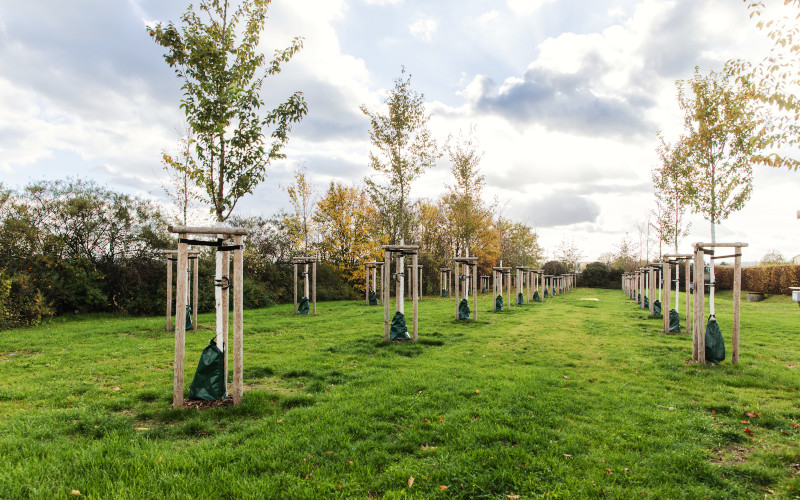Stormwater infiltration - rule-of-thumb numbers, construction methods and a calculation pathway
By Tom Kirsten
In research and standardization, offices, including members of the bdla, committees, universities and other bodies are currently working on new construction methods for water-sensitive planning.

Ideas are tested, some discarded, others pursued. Novel procedures are planned, coordinated and tested. Some of these novel processes are to be standardized. However, research results are usually published only after completion and evaluation of the respective trials. Details from the standardization work remain among the parties involved from the outset for good reasons.
Unfortunately, it can therefore take years, sometimes even decades, before a revised set of rules is presented. In view of climate change, current discussions and, not least, the commitment of our upcoming generation, these periods seem very long, if not too long.
Want to shorten the time it takes to process regulations? Get involved in committee work!
New rulemakings are not usually looked forward to by all stakeholders. However, if water-sensitive open space planning is to become the standard, robust research results, legal certainty and proven construction methods - in short, generally accepted rules of technology - are needed.
To shorten the wait for this, this article presents rules and figures of thumb from the practice of drainage planning. They are not yet generally known and have not yet attained normative status, if at all. Nevertheless, they can be used as practical tips to assist in planning.
Infiltration of rainwater
The simplest method for infiltration of precipitation water is surface infiltration; it comes closest to natural infiltration. Rainwater runs off paved surfaces without inlets or pipes into the side space, usually a lawn or planted area. The water is not temporarily stored and infiltrates directly there. Surface infiltration can also be dimensioned; the formulas can be found in the DWA-A 138-1 worksheet "Systems for the infiltration of precipitation water, Part 1: Planning, construction, operation", which has already been available in draft form since December 2020.
In this context, the infiltration area covered by rainfall is included in the catchment area. For moderately permeable soils, 30 percent to 50 percent of the connected area is needed for surface infiltration.
The permeability of lawns depends on the soil. The better the grasses are established and the more intensively the soil is rooted and enlivened, the more permeable the lawn, including the vegetation base layer, is to water. In the long-term operation of lawn troughs, a water permeability of about 1*10-5 m/s is established. In such a turf swale, about 36 mm of precipitation per hour percolates.
According to the draft of the DWA-A 138-1 worksheet, permanently permeable surface coverings, such as concrete pavers with a pile structure and the corresponding building inspectorate approval, are also to be used for surface infiltration in the future. Water can then be directed from adjacent surfaces, including roofs, onto these paved areas for infiltration.
The prerequisite for this is, of course, that the bedding, base course and subgrade are also sufficiently permeable to water. In addition, the paved areas must not be exposed to excessive loads. According to the new ZTV Wegebau, bedding material without zero content should be used for traffic areas that can be infiltrated. For example, 1/5, 2/5 or 2/8 mm aggregate can be used. These bedding materials are also used for surfaces in the use categories N2 and N3.
Infiltration swales are used to store surface runoff for a short period of time before it is allowed to infiltrate. Like surface infiltration, they should be filled over as wide an area as possible to avoid washout and uneven distribution. The swale can be made shallower if the feed is above ground. If infiltration swales are fed via channels, open channels are preferable. Deposits are easier to see in open channels, and open channels are easier to clean.

Common practice: planted lawn troughs
As a rule, infiltration swales are designed as lawn swales. In the future, such swales will also be planted; in many places, planting is already common practice. Infiltration swales must also be dimensioned according to worksheet DWA-A 138-1. For operational reasons, the height of the infiltration trough is limited to 30 cm. The required area of the swale also depends, in particular, on the catchment area and its fastening, the local rain data and the permeability of the soil. In the preliminary design, figures of thumb are used. If the soil is moderately permeable, 10 percent to 20 percent of the sealed catchment area is needed as the base area of the swale infiltration. Another rule-of-thumb figure states that 45 liters of storage volume is needed per square meter of connected impervious area.
Infiltration swales must empty within a foreseeable time after a heavy rain to be available for the next rain. It is generally assumed that swales must not be filled for more than 24 hours. However, this assumption is not covered by the regulations. It comes from the specifications for the design of stormwater retention swales, but different conditions and different design rules apply to their operation.
Infiltration of rainwater in relevant facilities assumes a water permeability of the soil of 1*10-4 m/s to 1*10-6 m/s. At these values, 360 mm/h infiltrate in permeable swales, up to 3.6 mm/h in less permeable swales. Therefore, if 30 cm of water accumulates in a swale, the drainage time must be between 50 minutes and 83 hours, three and a half days.
Does this mean that we will see full infiltration swales more often in the future? No, this will not be the case. The quantitative design rules have changed very little. The topsoil in a swale can also still store water before it percolates downward. This amount of water depends on the soil and is difficult to quantify; it is probably about 10 percent of the soil volume. This reserve volume contributes to the fact that the water level in infiltration swales is usually lower than designed.
Participate in the revision of regulations!
The small calculation example can also be applied to other infiltration systems and stormwater retention ponds with a throttled outlet if the emptying time is to be calculated. You determine how much water arrives at the facility and subtract from that the amount of water that infiltrates or drains to the sewer system over time.
New, more advanced construction methods and procedures for water-sensitive design in open spaces are urgently needed. From the perspective of landscape architects, the revision of the relevant regulations should be much faster. You want to shorten the processing time? Join in! The bdla offers a number of opportunities for active participation in committee work.
Author: Tom Kirsten, M.Sc., Saxon State Office for Environment, Agriculture and Geology, ö. b. v. expert for gardening and landscaping, sports ground construction - production and maintenance, bdla-speaker for construction engineering standards, Pirna. The text was published in the bdla association magazine "Landschaftsarchitekten" 1/2023.
Read all articles of the main topic "water strategies" of the bdla association magazine:
- Latitude: 0
- Longitude: 0


